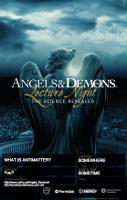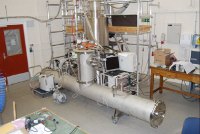 |
 |
|||||||||||||
|
|||||||||||||
|
|||||||||||||
|
Antimatter is likely to matter quite a lot in the next weeks. Hollywood has made its movie version of Dan Brown’s thriller Angels and Demons, directed by Ron Howard and starring Tom Hanks as Robert Langdon, and the film will hit cinemas around the world starting on 13 May. If you know the book you’ll know what ILC NewsLine has to do with it: it’s all about antimatter!
We do not want to spoil your cinema experience and will not give away the ending, but without revealing too much of the plot we can tell you that in the book, antimatter stolen from CERN threatens to destroy the Vatican. Behind it all is a secret brotherhood called Illuminati. If the brotherhood were to infiltrate the future ILC and tap its positron production line, could they end up with enough of the anti-electrons to threaten the world? “Not at all,” says one of the ILC's antimatter experts Jim Clarke of Daresbury Laboratory in the UK. He works on the positron source – the very source of the antimatter that will collide with normal matter – electrons – at high energies to produce new particles that could answer some of the most fundamental questions of physics. “First of all, the ILC won't store the positrons. We create them, send them through the damping rings and the accelerator, and 200 milliseconds later they crash into their antiparticles,” explains Clarke. For NewsLine, however, he sat down and did the calculation. Assume the ILC runs for ten years without shutdown. Assume 3 x 1014 positrons are produced every second (by the way: read more on progress with positron source R&D and how positron production works in NewsLine in the coming weeks) and stored, which is a challenge. The total positron count at the end of this runtime would be 1023, equivalent to roughly 90 microgrammes or 0.09 milligrammes of positrons. For comparison: the bomb in the book – a canister containing antimatter that would annihilate with the surrounding matter when no longer confined in a magnetic field – contained a quarter of a gram or 250 milligrammes of antimatter. It would therefore take thousands of years to produce enough positrons to fill the canister.
“If we were to store all of these 1023 positrons and then annihilate them by bringing them into contact with electrons then the energy generated would run the ILC itself for about 1 minute,” calculates Clarke. “I guess this gives you a pretty good idea of how inefficient it is to create antimatter in the first place…". Using antimatter as a weapon wasn't the only idea in the novel that made him smile. CERN definitely does not own an X-33 spaceplane, and he has yet to see his first Frisbee-playing Nobel laureate. “In the book, Georges Charpak throws Frisbees outside the CERN cafeteria,” recounts Clarke. “I met Charpak once – he seemed very nice, but not exactly like a Frisbee pro.” ILC Director Barry Barish enjoys books and has of course read Angels and Demons. “Science fiction writers are well known for their vivid imaginations,” he comments. “A canister of antimatter makes for an intriguing story, but in reality antiparticles are rather routinely produced and used in harmless ways in large particle accelerators. The ILC will produce many energetic positrons and with them we will unfold mysteries of nature that are every bit as intriguing, but nowhere near as dangerous, as those portrayed by Brown.” Would you like to know more about fact and fiction in novel, movie and real life? Check out CERN's new Angels & Demons website or the web pages of the US contribution to the LHC, where an impressive calendar lists all the lecture nights scientists give around the world on the Angels & Demons 'Science Revealed'. And if you're scheduled for such a lecture and are not on the list, or would like to give one and need help, let us know! -- Barbara Warmbein |
|||||||||||||
| © International Linear Collider |

